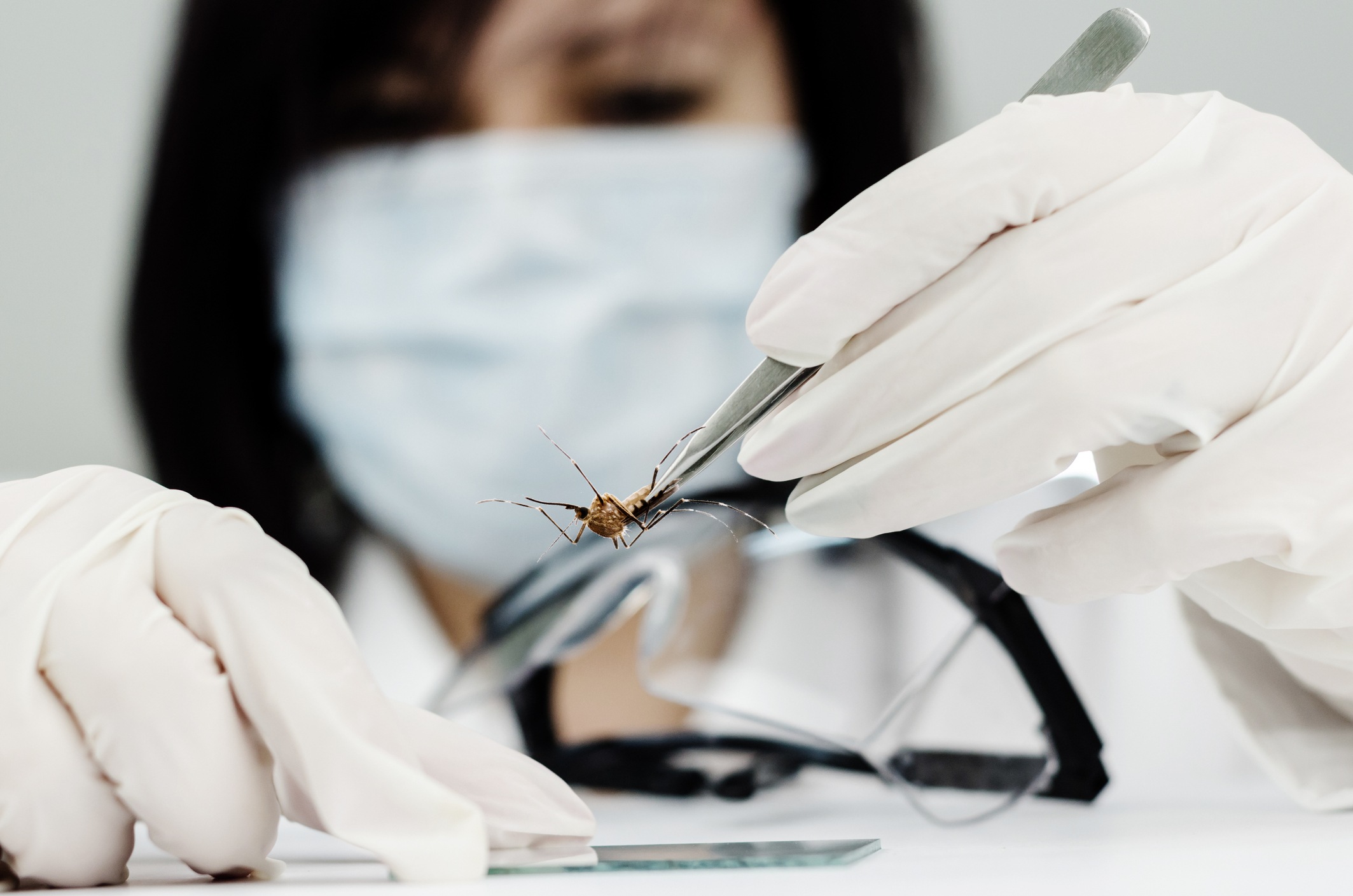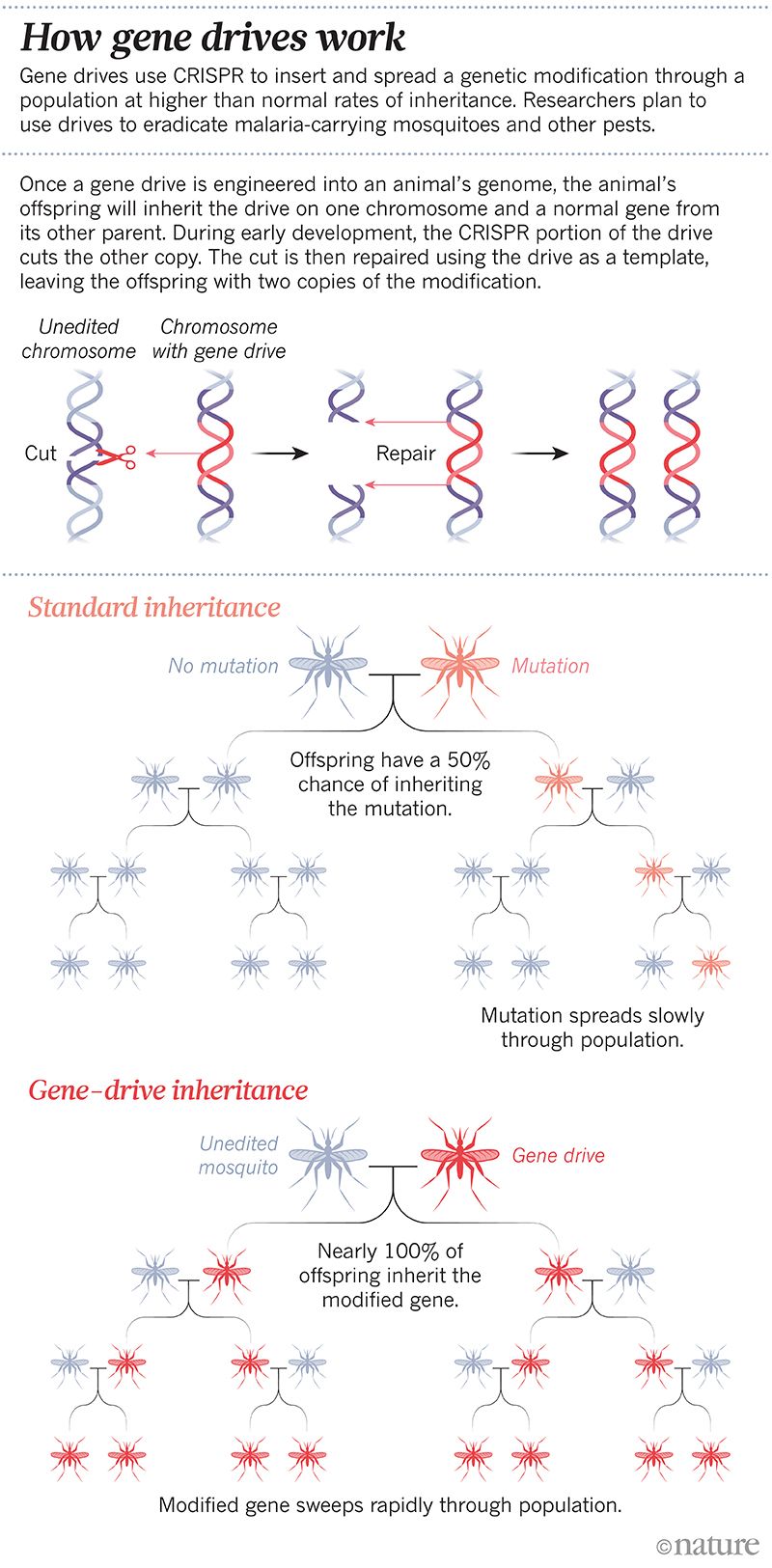
Malaria presents as one of the leading causes of disease and death in many developing countries. In 2016, the CDC estimates the disease to have accounted for 216 million cases, resulting in 445,000 deaths. The need for effective malaria treatments is eminent, but it is a particularly challenging disease to create vaccines or therapies for. One novel approach to this issue is not to treat or vaccinate humans, but rather to make mosquitoes invincible to malaria.
This approach revolves around the concept of gene drive, a genetic engineering technique that quickly spreads a specific gene throughout an entire population. Scientists have been working to create gene drives in insects for decades, however once CRISPR-Cas9 emerged, efforts towards gene drive in mosquitoes really took off. CRISPR-Cas9 is a gene editing tool that allows researchers to cut DNA and paste in genetic material of their choosing, creating genetically modified organisms.
The Science Behind CRISPR Gene Drive
This technique works by inserting the CRISPR-Cas9 gene into a specific segment of the mosquito’s DNA. CRISPR then induces the cell to copy its own gene onto the matching chromosome. By inserting itself into both chromosomes of the insect, the gene drive will then be passed down to all the mosquito’s offspring. CRISPR then copies itself onto the other chromosome repeats the process until the gene is within all individuals of a population.
By attaching another DNA segment to this CRISPR gene drive, scientists can have any gene of interest proliferate throughout an entire population. This was first done in early experiments with a protein that fluoresces red under a laser to confirm that the gene had successfully penetrated the population at a fast rate. Researchers then began to target genes that will hinder malaria transmission in mosquitoes.
Applying Gene Drive to Malaria
To make this gene drive truly work, researchers must choose an adequate gene target. Some genes are very conserved and cannot be altered without killing the host entirely. In September of 2018, researcher Andrea Crisanti and his team experimented with gene drive in an Anopheles gambiae mosquito population, the species that carries malaria. They created a drive that disrupts the fertility gene known as doublesex, which prevented the female mosquitoes from biting or laying eggs. Being that male mosquitoes cannot bite this would theoretically render all mosquitoes affected by the gene drive unable to transmit malaria. The doublesex gene is also resistant to mutations, making it an excellent candidate for this drive.
What Crisanti found was that the edited gene penetrated the target population with 100% efficiency, and within 8-12 generations there were no eggs at all in the samples. These researchers conducted nine cage experiments using over one million gene insertions targeting the doublesex gene without seeing any resistance, but the team is now adapting the drive to affect two regions of this gene.
“I want to make sure that the likelihood of developing resistance is very, very remote before saying the technology is ready for the field,” explains Crisanti.
Gene drives are unique in that they spread on their own, according to Fredros Okumu, director of science at the Ifakara Health Institute in Dar es Salaam, Tanzania. “We’ve got to prepare people and share information openly with all the countries concerned,” he says.
Challenges Associated with Gene Drive
One of the greatest challenges associated with this mission are those tied to social and ethical issues, with organizations like Friends of the Earth voicing complaints about making such a drastic change in nature. These groups are concerned about the implications of making an entire species go extinct, being that this could disrupt the ecosystem in several ways.
“These genetic extinction technologies are false solutions to our conservation challenges”, said Dana Perls, member of the Friends of the Earth delegation at the COP 13. “We want to support truly sustainable and community driven conservation efforts. Gene drives could be co-opted by agribusiness and military interests. We need a moratorium on irreversible and irresponsible technologies such as gene drives.”
Dr. Abdoulaye Diabaté of Target Malaria noted that this gene drive would not necessarily eradicate the world of all mosquitoes as many think.
“First of all, let me tell you that we have about 3,500 species of mosquitoes across the world. And just for the region of Africa, we have 850 species. So Target Malaria is just targeting only one species, which is a major malaria victory in Africa and mostly Burkina Faso. So if targeting only one species can help to save millions of lives, I think it’s really important and worth doing it,” Diabaté explained in an interview.
Another concern is whether the gene drives will even work, with animals in labs developing mutations that often stop the spread of the drive. For instance, if there is a mutation in the sequence that CRISPR-Cas9 is supposed to recognize, then the gene is not able to be inserted. While working with Target Malaria researcher Tony Nolan, Crisanti saw a gene drive decrease in frequency over time because of this resistance.
There is yet to be a release of a gene drive in the wild, but researchers feel that this could become possible in the next three years. Recently on July 1, the non-profit Target Malaria released genetically engineered mosquitoes in a Burkina Faso village. These mosquitoes were not engineered with gene drives yet but were simply released in a test exercise. Diabaté claims they have been working on this project since 2012, and the team hopes that this mosquito release will improve society’s view of the gene drive effort.
Target Malaria did another release in August 2018 with the authorization of the National Biosafety Agency of Burkina Faso. In this effort, they released a male mosquito population that was genetically modified to be sterile. This was the first release of genetically edited mosquitoes in Africa.
Building a gene drive to manipulate or eradicate a population is like picking a fight with natural selection – that fight might not be easy to win. https://t.co/7ER0aKdAAK
— Nature News & Comment (@NatureNews) July 11, 2019








 © 2025 Mashup Media, LLC, a Formedics Property. All Rights Reserved.
© 2025 Mashup Media, LLC, a Formedics Property. All Rights Reserved.